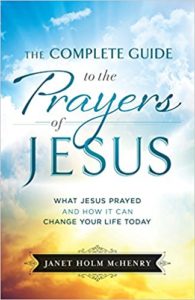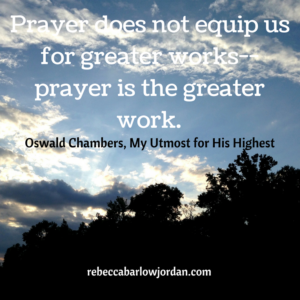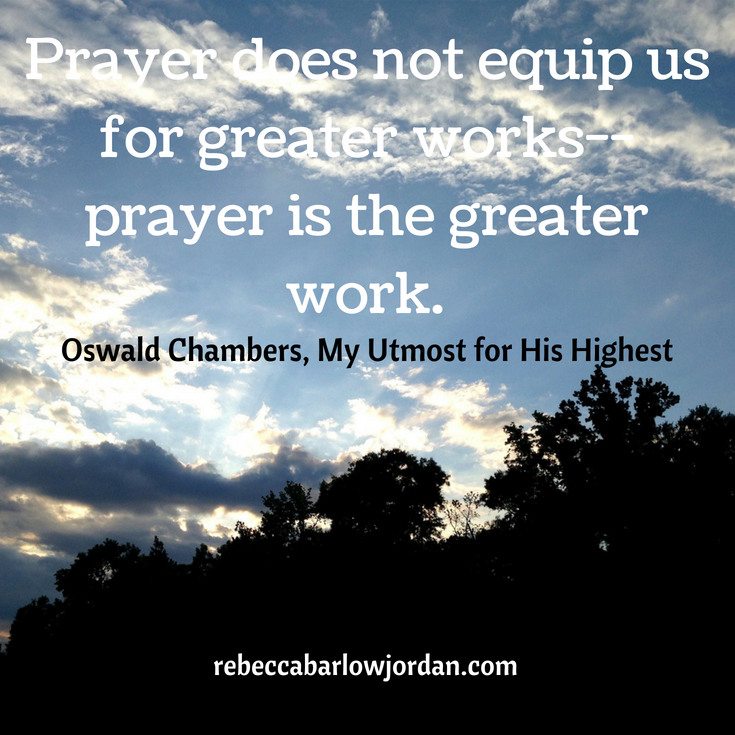One of my favorite quotes on prayer is by Oswald Chambers: “Prayer does not equip us for greater works–prayer is the greater work.”¹ And where else can you find out how to do the “greater work” in prayer than through the prayers of Jesus? He is indeed the perfect Prayer Mentor.
 One of the best books I’ve run across on prayer recently is one by an author friend of mine, Janet McHenry: The Complete Guide to the Prayers of Jesus. This book goes beyond the Lord’s Prayer, with which most of us are familiar. It takes us through the ten recorded prayers of Jesus and includes both his practices and teachings on prayer. And best of all, this book gives us a wonderful glimpse into the character of our Heavenly Father.
One of the best books I’ve run across on prayer recently is one by an author friend of mine, Janet McHenry: The Complete Guide to the Prayers of Jesus. This book goes beyond the Lord’s Prayer, with which most of us are familiar. It takes us through the ten recorded prayers of Jesus and includes both his practices and teachings on prayer. And best of all, this book gives us a wonderful glimpse into the character of our Heavenly Father.
The Complete Guide to the Prayers of Jesus
Janet has agreed to a Q & A session today on my blog, so I’m delighted to introduce her and her newest book to you.
Q: How did your interest in prayer begin?
Twenty years ago I headed down my back door steps and found myself in a crumpled heap because my knee had given way. I knew I needed to do something about my health, so I decided to start walking in the morning. I also knew that for some time God had been nudging me to spend more time in prayer, so I decided to pray while I walked. One morning, though, God changed my prayer outlook when I saw a young man hand his blanketed baby girl over to a daycare worker on the sidewalk in front of the local daycare center. The little girl said, “Bye, Daddy. Love you.” I knew from that moment that God had me out walking and praying not so much for my own prayer needs but for the purpose of praying for whatever he put within my eyesight. So I began prayerwalking—praying for the people of my community.
Q: In your new book, The Complete Guide to the Prayers of Jesus, you refer to Jesus as a teacher or mentor in prayer. How did that perspective develop?
After I started prayerwalking, I became hungry to know more about prayer. I started reading all kinds of books on prayer, but more importantly, I began looking for references to prayer in the Bible as I read through it each year. As I found a prayer or a teaching on prayer, I marked it with a circled P in the margin of my Bible. I began to focus on what Jesus taught about prayer, his prayers, and his prayer practices. After all, he came to earth so that we might know the Father. He is our mediator, our intercessor, and our high priest who advocates in our behalf. The book, then, is a culmination of nearly 20 years of studying and teaching about Jesus’ prayer life.
Q: Why did Jesus pray? And how did he pray?
We don’t have a direct statement from Jesus recorded in the gospels as to why he prayed, but we do have his example. Luke wrote that Jesus often withdrew to lonely places to pray (Luke 5:16) and that he spent nights praying to God (Luke 6:12). We can imply from these texts that he needed to be with his Father. The physical separation must have been difficult. Even an ordinary life is challenging; his was short—with his three years of ministry constantly draining. Even as a young boy when separated from his parents for three days, Jesus told his mother Mary, “Didn’t you know that I had to be in my Father’s house?” (Luke 2:49). That was the thing: Jesus had to be in his Father’s house. He needed to communicate with his Father and to hear from him away from the madding crowd. Prayer allows us to be in our heavenly Father’s house in a figurative way.
Q: How did Jesus pray?
Jesus prayed simply. If you look at the prayers of his that we have—only ten actual prayers—you find simple language. It’s not elevated or flowery or formal. He taught we should pray simply and modeled that.
He also prayed privately. He went up the mountainside in Capernaum to pray away from the ears of others. He taught that we should pray not in public so as to receive the praise of men but behind closed doors. And because we do have ten of his prayers recorded, we know that Jesus did pray in front of others.
In terms of the kinds of prayer Jesus prayed, he offered praise and thanksgiving, and he prayed for others and himself. He asked the Father to forgive others but also echoed a lament from the Psalms. Jesus perhaps offered the best possible human prayer when he asked God to take the cup from him, “Yet not as I will, but as you will” (Matthew 26:39). I call this the dichotomous, two-sided coin prayer. The one side of the prayer expresses the cry of our human heart, while the other asks God that his heart-wish be accomplished through us. These are just some examples—there are many more teachings and practices we can learn from Jesus’ prayer life.
Q: How did Jesus pray in times of trouble?
Actually, most of his prayers that we have are from the last week of his life. The first of those was one I’d always overlooked. He had ridden into Jerusalem for the last time on a donkey, and a crowd greeted him with palm branches and cries of “Hosanna!” (John 12:12-13). However, afterwards when with his disciples, he said his heart was “troubled.” In a tough situation, what do most of us pray? “Save me!” But Jesus said he wouldn’t pray “save me from this hour” but instead prayed, “Father, glorify your name!”
Every word and action of Jesus led to this prayer—that the Father would be glorified through his life. He came to earth to point others Godward. Thus, he would not pray “save me,” because “save me” was not part of the plan for his life. This one prayer has significantly changed the way I pray. I simply ask God to be glorified through me—what I say, what I do, and even what I think.
Q: And the Father didn’t save his Son from the cross. Why doesn’t God answer some prayers?
I don’t know, and I don’t think we always can know on this side of life. One thing I did observe as I studied Jesus’ prayer life was that he prayed, “Why have you forsaken me?” And that is the toughest question we also will have: Why? Why did I lose my job? Why did my sister Nan die of cancer? Why did my dad die of ALS? These are very real Why? questions I have had in my life.
But here’s one thought: Because Jesus was forsaken—abandoned—we can be adopted by the Father as his son or daughter. Permit me an analogy. A baby’s abandonment on a doorstep seems horrible. But that child’s abandonment could become the answer to the heart cries of a married couple who has dearly wanted to have a child of their own. Abandonment can lead to adoption. Jesus chose to be forsaken, so that we would not be.
Q: So, why pray at all? What should we expect when we pray?
We can expect that God will show up. Prayer is a demonstration of faith, and God honors steps of faith. As Jesus did, we can thank the Father in advance for what he will do. That’s how Jesus prayed before Lazarus was resurrected from the dead: “I thank you that you have heard me.” Before the loaves and fish were multiplied, Jesus gave thanks. He taught us to pray with bold expectation, because we worship the God who can do the impossible. So, I believe the wooden sign on my kitchen wall–“pray big”—because I serve a big God.
Author Bio of The Complete Guide to the Prayers of Jesus
Janet Holm McHenry is the author of 23 books—six of those on prayer, including the bestselling PrayerWalk and The Complete Guide to the Prayers of Jesus. Featured on radio and in magazines, including Health and Family Circle, Janet is known for prayerwalking her small town in the Sierra Valley, where she and her husband, Craig, raised four children. She coordinates the prayer ministries at The Bridge Church in Reno, organizes an annual prayerwalk for the schools, and speaks around the country about developing a deeper relationship with her prayer teacher, Jesus.
You can read more about Janet on her website, Looking Up.
You might also enjoy this post I wrote regarding prayer, called 5 Prayers God Loves to Hear.
¹Oswald Chambers, My Utmost for His Highest, (Grand Rapids MI: Discovery House, 1992) October 17
Share with Others
Using the share buttons, feel free to share about my website or this blog post with others on social media circles so we can work together in encouraging others toward intimacy with God. And if you haven’t signed up for my posts and newsletter updates, I hope you’ll do so soon. I think you’ll enjoy the complimentary ebook that you’ll receive when you sign up. If you are visual, like me, you can also join me and follow my boards on Pinterest.






